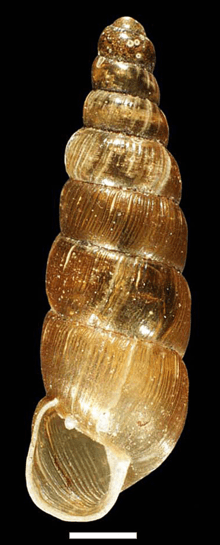Balea perversa
| Balea perversa | |
|---|---|
 | |
| live Balea perversa | |
| Scientific classification | |
| Kingdom: | Animalia |
| Phylum: | Mollusca |
| Class: | Gastropoda |
| (unranked): | clade Heterobranchia
clade Euthyneura |
| Superfamily: | Clausilioidea |
| Family: | Clausiliidae |
| Subfamily: | Baleinae |
| Genus: | Balea |
| Species: | B. perversa |
| Binomial name | |
| Balea perversa (Linnaeus, 1758)[1] | |
| Synonyms | |
| |
Balea perversa is a species of air-breathing land snail, a terrestrial pulmonate gastropod mollusk in the family Clausiliidae, the door snails. The shell of this species is left-handed in coiling and it looks like a juvenile of a clausiliid.
Balea perversa (as its synonymous name Pupa fragilis) is the type species of the genus Balea.
Distribution
The distribution of this species is from Western Europe to Crimea:
- British Isles:[2] Great Britain and Ireland
- Western Europe[2]
- Switzerland - lower concern in Switzerland[2]
- Portugal[2]
- Germany - vulnerable in Germany, endangered in Bavaria [2]
- Austria - vulnerable in Austria[2]
- Czech Republic[3]
- Slovakia[3]
- on an islet near Estonia[4]
- Sicilia[2]
- Sardinia[2]
- Iceland[2]
- in Scandinavia only coastal above 62° N[2]
It was referred from Crimea,[2] but it was probably Mentissa gracilicosta.[4]

Description
The shell is small and resembles that of a juvenile clausilid. The color is pale brownish and the surface is often silky shiny. The shell often has distinct riblets. The apical whorls are cylindrical. The shell has 8-9 whorls and (unlike many clausiliids) the last whorl has the largest diameter. It is densely ribbed. The cervix is almost without keel. Apart from a rudimentary parietal fold, there are no folds in the aperture. This species has no clausilium.[2]
The width of the shell is 2.5-2.7 mm; the height of the shell is 7-10 mm.[2]
Balea perversa differs from Balea heydeni in that it is a less slender and brownish rather than yellowish shell; the first whorl increases in diameter less rapidly, and the sculpture is more prominently striated (with what are usually distinct riblets rather than coarse growth lines).[2]
 Apertural view. |
 Lateral view. |
Ecology
Balea perversa lives on mosses and at the bark of trees, also near roads, at walls and rocky slopes, at rocks, less commonly in ground litter.[2] It lives often on surfaces encrusted with lichens and other epiphytes.[2] It prefers trees with rough bark.[2] It prefers shady habitats in Portugal.[2] It may tolerate non-calcareous soils.[2] In Bulgaria it lives up to 1600 m, perhaps 2400 m, in Switzerland up to 2000 m.[2]
It is easily dispersed by birds.[2]
It feeds on mosses, algae, lichens and cyanobacteria.[2]
It is ovoviviparous, self-fertilization predominates, even in laboratories when snails are kept in pairs.[2] Animals can reach maturity after 3-4 months under favourable conditions, one adult can give birth to 10-20 juveniles per year.[2] Animals can also be active in mild winters.[2]
It is locally threatened by too thorough and too frequent restorations of old buildings, acid rains, air pollution and cutting of old trees.[2] It has largely disappeared from inside cities.[2] Remains frequent in Ireland, but many colonies in lowland England have certainly disappeared, extinct around London since the 1920s.[2]
References
This article incorporates public domain text from the reference [2]
- ↑ Linnaeus C. (1758). Systema naturae per regna tria naturæ, secundum classes, ordines, genera, species, cum characteribus, differentiis, synonymis, locis. Tomus I. Editio decima, reformata. - pp. [1-4], 1-824. Holmiæ. (Salvius). page 767.
- 1 2 3 4 5 6 7 8 9 10 11 12 13 14 15 16 17 18 19 20 21 22 23 24 25 26 27 28 29 "Species summary for Balea perversa". AnimalBase, last modified 12 April 2011, accessed 17 April 2011.
- 1 2 (Czech) Horsák M., Juřičková L., Beran L., Čejka T. & Dvořák L. (2010). "Komentovaný seznam měkkýšů zjištěných ve volné přírodě České a Slovenské republiky. [Annotated list of mollusc species recorded outdoors in the Czech and Slovak Republics]". Malacologica Bohemoslovaca, Suppl. 1: 1-37. PDF.
- 1 2 Kantor Yu I., Vinarski M. V., Schileyko A. A. & Sysoev A. V. (published online on March 2, 2010). "Catalogue of the continental mollusks of Russia and adjacent territories". Version 2.3.1.
External links
| Wikimedia Commons has media related to Balea perversa. |
- Balea perversa at Animalbase
- Balea perversa images at Encyclopedia of Life
- "Balea perversa". National Center for Biotechnology Information (NCBI).